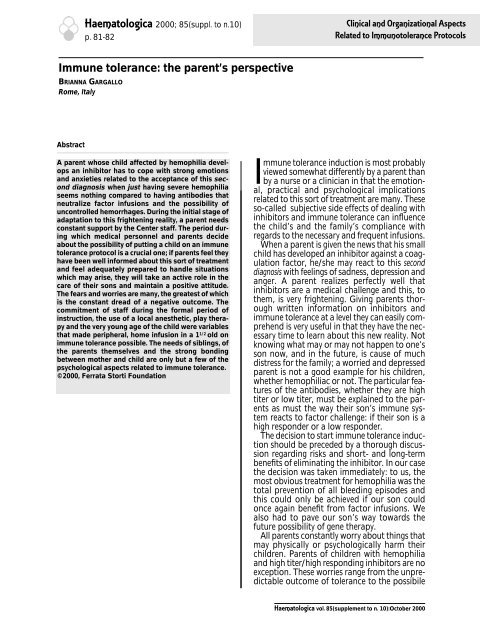Haematologica 2000;85:supplement to no. 10 - Supplements ...
Haematologica 2000;85:supplement to no. 10 - Supplements ...
Haematologica 2000;85:supplement to no. 10 - Supplements ...
Create successful ePaper yourself
Turn your PDF publications into a flip-book with our unique Google optimized e-Paper software.
<strong>Haema<strong>to</strong>logica</strong> <strong>2000</strong>; <strong>85</strong>(suppl. <strong>to</strong> n.<strong>10</strong>)<br />
p. 81-82<br />
Clinical and Organizational Aspects<br />
Related <strong>to</strong> Immu<strong>no</strong><strong>to</strong>lerance Pro<strong>to</strong>cols<br />
Immune <strong>to</strong>lerance: the parent’s perspective<br />
BRIANNA GARGALLO<br />
Rome, Italy<br />
Abstract<br />
A parent whose child affected by hemophilia develops<br />
an inhibi<strong>to</strong>r has <strong>to</strong> cope with strong emotions<br />
and anxieties related <strong>to</strong> the acceptance of this second<br />
diag<strong>no</strong>sis when just having severe hemophilia<br />
seems <strong>no</strong>thing compared <strong>to</strong> having antibodies that<br />
neutralize fac<strong>to</strong>r infusions and the possibility of<br />
uncontrolled hemorrhages. During the initial stage of<br />
adaptation <strong>to</strong> this frightening reality, a parent needs<br />
constant support by the Center staff. The period during<br />
which medical personnel and parents decide<br />
about the possibility of putting a child on an immune<br />
<strong>to</strong>lerance pro<strong>to</strong>col is a crucial one; if parents feel they<br />
have been well informed about this sort of treatment<br />
and feel adequately prepared <strong>to</strong> handle situations<br />
which may arise, they will take an active role in the<br />
care of their sons and maintain a positive attitude.<br />
The fears and worries are many, the greatest of which<br />
is the constant dread of a negative outcome. The<br />
commitment of staff during the formal period of<br />
instruction, the use of a local anesthetic, play therapy<br />
and the very young age of the child were variables<br />
that made peripheral, home infusion in a 1 1/2 old on<br />
immune <strong>to</strong>lerance possible. The needs of siblings, of<br />
the parents themselves and the strong bonding<br />
between mother and child are only but a few of the<br />
psychological aspects related <strong>to</strong> immune <strong>to</strong>lerance.<br />
©<strong>2000</strong>, Ferrata S<strong>to</strong>rti Foundation<br />
Immune <strong>to</strong>lerance induction is most probably<br />
viewed somewhat differently by a parent than<br />
by a nurse or a clinician in that the emotional,<br />
practical and psychological implications<br />
related <strong>to</strong> this sort of treatment are many. These<br />
so-called subjective side effects of dealing with<br />
inhibi<strong>to</strong>rs and immune <strong>to</strong>lerance can influence<br />
the child’s and the family’s compliance with<br />
regards <strong>to</strong> the necessary and frequent infusions.<br />
When a parent is given the news that his small<br />
child has developed an inhibi<strong>to</strong>r against a coagulation<br />
fac<strong>to</strong>r, he/she may react <strong>to</strong> this second<br />
diag<strong>no</strong>sis with feelings of sadness, depression and<br />
anger. A parent realizes perfectly well that<br />
inhibi<strong>to</strong>rs are a medical challenge and this, <strong>to</strong><br />
them, is very frightening. Giving parents thorough<br />
written information on inhibi<strong>to</strong>rs and<br />
immune <strong>to</strong>lerance at a level they can easily comprehend<br />
is very useful in that they have the necessary<br />
time <strong>to</strong> learn about this new reality. Not<br />
k<strong>no</strong>wing what may or may <strong>no</strong>t happen <strong>to</strong> one’s<br />
son <strong>no</strong>w, and in the future, is cause of much<br />
distress for the family; a worried and depressed<br />
parent is <strong>no</strong>t a good example for his children,<br />
whether hemophiliac or <strong>no</strong>t. The particular features<br />
of the antibodies, whether they are high<br />
titer or low titer, must be explained <strong>to</strong> the parents<br />
as must the way their son’s immune system<br />
reacts <strong>to</strong> fac<strong>to</strong>r challenge: if their son is a<br />
high responder or a low responder.<br />
The decision <strong>to</strong> start immune <strong>to</strong>lerance induction<br />
should be preceded by a thorough discussion<br />
regarding risks and short- and long-term<br />
benefits of eliminating the inhibi<strong>to</strong>r. In our case<br />
the decision was taken immediately: <strong>to</strong> us, the<br />
most obvious treatment for hemophilia was the<br />
<strong>to</strong>tal prevention of all bleeding episodes and<br />
this could only be achieved if our son could<br />
once again benefit from fac<strong>to</strong>r infusions. We<br />
also had <strong>to</strong> pave our son’s way <strong>to</strong>wards the<br />
future possibility of gene therapy.<br />
All parents constantly worry about things that<br />
may physically or psychologically harm their<br />
children. Parents of children with hemophilia<br />
and high titer/high responding inhibi<strong>to</strong>rs are <strong>no</strong><br />
exception. These worries range from the unpredictable<br />
outcome of <strong>to</strong>lerance <strong>to</strong> the possibile<br />
<strong>Haema<strong>to</strong>logica</strong> vol. <strong>85</strong>(<strong>supplement</strong> <strong>to</strong> n. <strong>10</strong>):Oc<strong>to</strong>ber <strong>2000</strong>
















